 Royal Navy
Royal Navy

Most
of the Ship's Badges/Crests displayed on these pages were supplied by
Mike
Waugh.
d.waugh@paradise.net.nz
Should
you wish to copy any, please obtain his permission first.
I
served with the Royal Navy from 1956 to 1967 and the RNR until
1981 leaving as a CPOSA (S).
I
would be pleased to hear from any shipmates, from the following
RN
Ships;
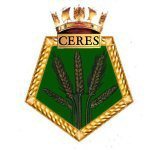
HMS Ceres ( Wetherby )1956/57 Royal Naval Supply School, I
was in 45S Class.
Photographs wanted
of the classes
or buildings, especially Moorlands?

Me on my first leave from HMS Ceres Christmas 1956


Baby Airy Fairies, learning their trade.

Gamecock
Barracks on a Winter's Day.
HMS Gamecock
1957, Royal Naval Air Station Bramcote, Fleet Air
Arm Training Establishment. Photographs wanted,
I was ship's company.
Royal Navy: 1946 – 1959
The Royal Navy took over Bramcote Station on 3 December 1946. It became known as
Royal Navy Air Station, Bramcote ‘HMS Gamecock’. The ship’s badge was ‘a
gamecock proper’ on white background with the motto ‘spurred for the skies’
At the commissioning ceremony, captain G N Brewer DSO, Officer Commanding,
remarked to the assembled gathering “you have seen the white ensign hoisted for
the first time about as far from the sea as it is possible in England. You are
serving in the most inland ‘stone frigate’ in the country”.
The main function of RNAS Bramcote was to be the technical training for Naval
Airmen Aircraft Mechanics.
About one thousand men were under training at any one
time. After completing new entry and airmanship courses, the trainee then joined
an aircraft carrier for one month’s sea experience.
HMS Gamecock was also a centre for the Royal Naval Volunteer Reserve (Air
branch) and was used by 1833 (RNVR) Squadron. This squadron started its flying
at Bramcote with Seafires (the naval version of the Spitfire). The early 1950s
saw an expansion of the RNVR and in 1954, 1833 squadron got its eagerly awaited
Sea Furies. There were also a small number of Firefly aircraft and on 15
February 1954, this element was formed into 1844 squadron, which concentrated on
anti-submarine training. Both Squadrons were distinguished by having their
spinners (propellers) painted red – this being the unofficial station colour.
All aircraft based at Bramcote, were identified by the letters BR painted on the
tail fin.
On 23 October 1955, 1833 squadron were moved to RAF Honiley – near
Coventry – as they were to be equipped
with jet aircraft as Bramcote had grass runways.
In March 1956, 1844 squadron re-equipped with Grumman Avengers. They no longer
had red spinners but the cowlings now bore a red diamond with a squadron crest
on a white inner.
HMS Gamecock, as the name implies, suggests an association with the game bird
and it is believed that a cock-fighting pit did exist within the station
perimeter – not far from the Officers Mess. It is not surprising to find
therefore that the Navy had a mascot – yes – a gamecock. The first one was
‘Wallis’ – to be followed by many more and he was paraded in his spherical cage
at ceremonial parades.
With the run down of the RNVR (Air Branch) Bramcote eventually became surplus to
requirements for the Navy and the training was transferred to Arbroath. During
the long run down the local press headlined the question “what is to happen to
HMS Gamecock? Their fears were alleviated by the announcement that the camp was
to receive new tenants.
The Army


HMS Tracker (LST(3) 3522)
Tank Landing Ship.1957.
Lots of good info on all the LSTs
http://www.lutonmodelboat.co.uk/history_lst.html
The second ship to bear the
name,
HMS Tracker was one of the many Landing Ship, Tanks
(LST's) constructed in the latter stages of the Second World War.
The hull was built by Davie Shipbuilding, Lauzon and
engined by C.P. Rail.
She was launched on the 9th June 1945 as L3522.
She was named HMS Tracker in 1947.
In 1952 HMS Tracker acted as the hospital ship for
the first British atom bomb test off the North West coast of Australia.
In 1957 she became a harbour accommodation ship for
the pre-commissioning crew standing by HMS Victorious.
She became a net and boom carrier in 1964.
She was sold in 1970 and scrapped in
Valencia Spain in 1971.
Were
you a part of Tracker '57 crew standing by for the Victorious?, did anyone take
any photographs?
I
know we had some good laughs and runs ashore, we also worked bloody hard.
I
was only sixteen when I joined her and I had to work like a mule, talk about
slave labour.
It
took us a year, to store the "Mighty Vic".
Humping
144lb bales of rags, sacks of soda, spuds, 5 gal drums of Teepol etc. lorry load
after lorry load.
It
was all carried over the gangway and through the decks, because the miserable
"B" of a flight deck commander didn't want his flight deck
dirty.
How
simple and easy would have it have been, to hoist the lorries on board by crane
and lower the supplies down the storing hatches.
The
way the ship was designed to be stored; and was, when she commissioned and went
to sea.
A
sign of the times I suppose, the OSHA safe carrying weight now is 20 kilos 50
lbs.

photo courtesy of " To Sail No More part four, Ian Buxton,
published by Maritime Books, isbn 0--907771-77-7 Lodge Hill, Liskeard Cornwall, UK, 01579-343663


HMS Victorious ( R38 ) Aircraft Carrier.
1957/60,
http://www.fleetairarmarchive.net/Ships/Victorious.html


Royal Naval Barracks Chatham,
HMS Pembroke
Royal Naval Supply
School 1960/62.

Chatham Barracks is now the University of Greenwich.
I
was small ships support team.


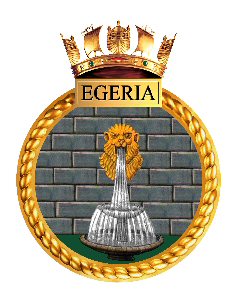
Including E.C.E.S.U. (East Coast of England Survey Unit) HMS
Echo, HMS Enterprise, HMS Egeria.

HM
Ships Echo,
Enterprise, Egeria, Plymouth 1962

HMS Osprey,
Helicopter Station and Naval Base 1962/63,

Photographs
wanted, I was Small Ship's Support Group.

HMS Rooke Gibraltar1963/65,

I was
Small Ship's Support Group, mothballed
Ton Class
Minesweepers
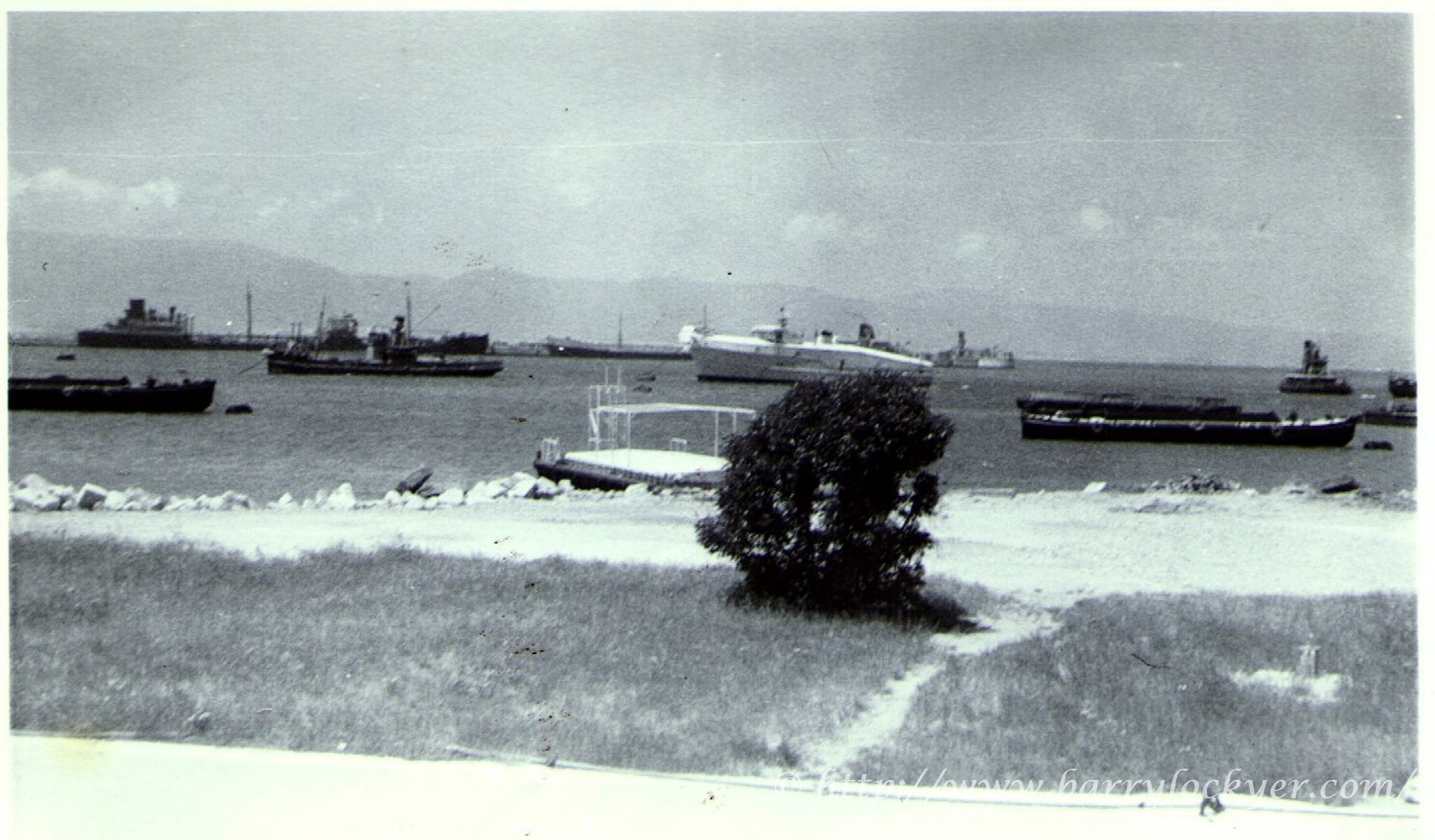
HMS Rooke swimming pontoon and a Ton class minesweeper with mothball
arking off the foreshore.
and
HMS Grenville.

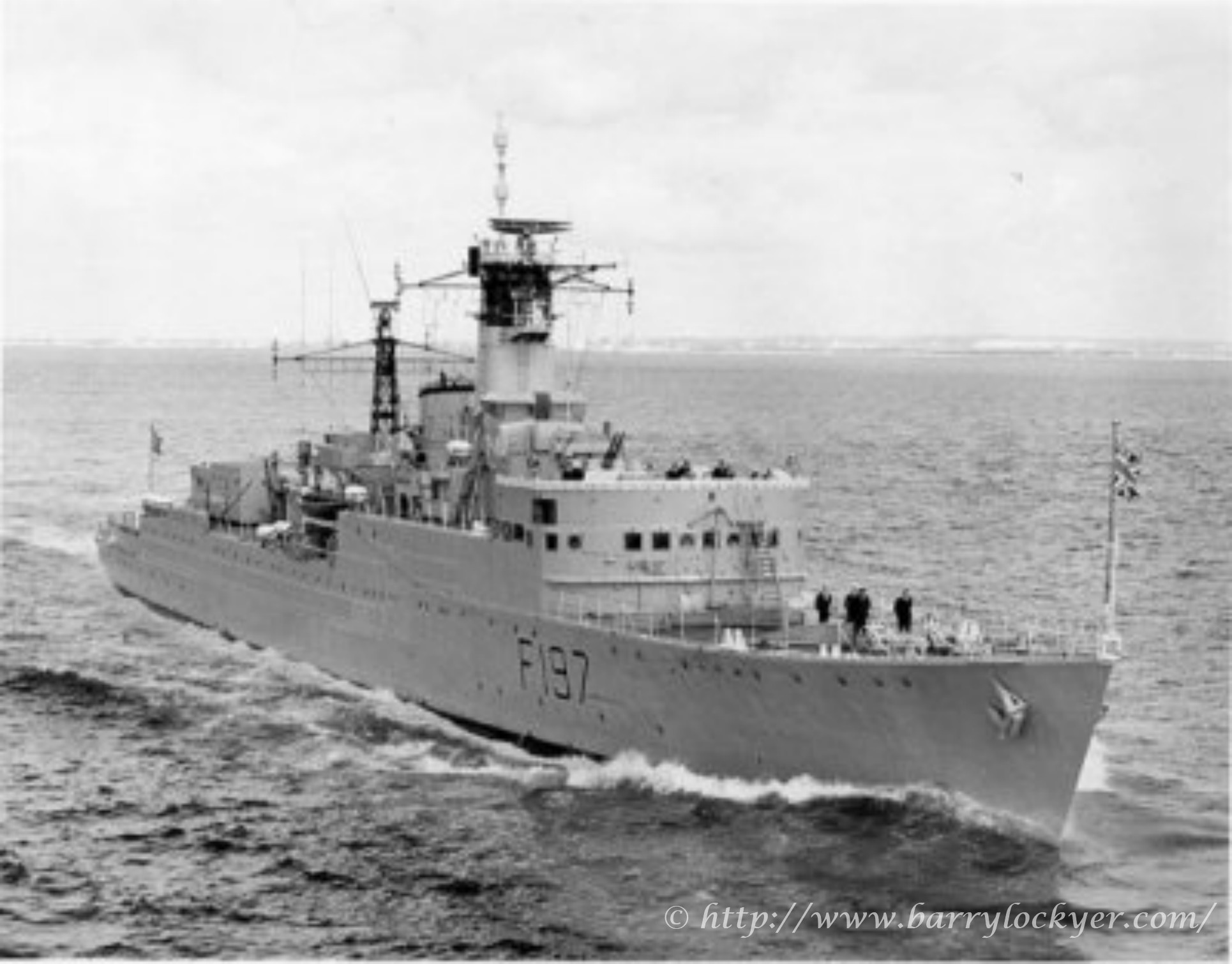
H.M.S. Grenville


HMS Fittleton, except they all had cocooning on, made them look like Noah's Ark
Does anyone have photographs of the Ton Class mothball
fleet in Gibraltar, I think we had thirteen, can you remember their names???
We would bring one alongside every month and change the
provisions, survival packs, fresh water etc.
I remember one Winter's day, the wind was howling through
the two moles, directly on to Coaling Island Jetty, where we had the sweeper, she was
swaying, side to side so violently, I had to go ashore in case I was seasick.
Luckily we had a married quarter in Cormorant " O " Block, at the shore end of
the Jetty.

Rifle Match results in Gibraltar Daily Paper.
We had a very good Small Bore Rifle Team and won the Local Trophy beating the
formidable Gibraltar Security Police.
We drove home overland to the UK April 1965, I hadn't
finished my Foreign Service Leave, when I got a telegram, telling me to join HMS
Tiger at Guzz Plymouth to you landlubbers.
I was back in Gibraltar onboard H.M.S. Tiger, twenty eight days after leaving, no tropical
kit, it was all en route to the UK, we probably passed it in the Bay of Biscay,
I had to go ashore to HMS Rooke to get kitted out, all the Jack Dusty's in the
clothing store, got a
laugh when I turned up.
That first night in, we were playing tombola in the fleet
club, a sparker from Rooke, asked me if my missus had let me out for the night.


HMS Tiger
( C20 ) 6" Cruiser, 1965/66.
I was the LSA (S) in charge of the Permanent Stores
Ledgers and Loan Lists, under CPOSA (S) Dennis Deighton;
a true naval gentleman, where are you now Dennis.???
Tiger Class Light Cruisers
Displacement: 9,550 tons standard ; 11,700 tons full load
Dimensions: 538 pp, 555.5 oa x 64 x 18 feet
Propulsion: 4 shaft Parsons geared turbines, 4 Admiralty 3-drum boilers,
80,000 shp. = 31.5 knots
Range: 2000 miles at 30 knots, 6,500 miles at 12 knots ; 1,940 tons fuel
oil
Complement: 716
Armament: 2 dual 6-inch / 50 Mk 26 DP rapid-fire ; 3 dual 3-inch / 70 Mk
6 DP rapid-fire
Armour: 3.25 to 3.5 inch belt ; 2 inch deck ; 1 to 2 inch turrets ; 1.5
to 2 inch bulkheads
Radars: Air Search - Type 960 ; Surface/Low-level Air Search - Type 992 ;
Height Finding - Type 277Q ; Gunnery - Type 903 (MRS3 director) per mount
Helicopter Cruiser conversion as above except:
Displacement: 9,500 tons standard ; 12,080 tons full load
Dimensions: 538 pp, 556.6 oa x 64 x 18 feet
Complement: 885
Armament: 1 dual 6-inch / 50 Mk 26 DP rapid-fire, 1 dual 3-inch / 70 Mk 6
DP rapid-fire, 2 quad GWS22 Seacat SAM launchers
Aircraft: 4 Wessex / Sea King HAS
Radars: Air Search - Type 965 ; Surface/Low-level Air Search - Type 992Q
; Height Finding - Type 278 ; Gunnery - Type 903 (MRS3 director) per mount
These three ships were laid down as Group 2 Swiftsures with Superb.
All were suspended at the end of war, work not restarting until the mid 1950's.
They were then completed to a modified design utilising the new 6-inch and
3-inch rapid-fire DP guns designed for the abandoned 'Minotuar' class. These
guns gave the class the greatest fire-power of any cruiser the Royal Navy had
ever built, with the water cooled 6-inch and 3-inch guns capable of firing 20
and 90 rounds per minute per gun respectively (although this rate of fire would
empty the magazines in a few minutes). Unfortunately the guns suffered
reliability problems.
Shortly after entering service, Tiger & Blake were
converted to ASW Helicopter Cruisers embarking 4 Sea King or Wessex
anti-submarine helicopters, with the aft 6-inch twin turret replaced by a hanger
and flight deck and the two amidships 3-inch twin turrets replaced by Seacat
point defence SAMs. Due to the high manpower they required all three ships spent
several years in reserve, with Lion only serving 4 years before
being paid off.
Blake was the last cruiser in the Royal Navy and in December 1979
ended a 100 year tradition of RN Cruisers.

HMS Tiger (C20)
(ex Bellerophon)
Built by John Brown, Clydebank. Laid down 1 October 1941. Launched 25 October
1945. Completed 18 March 1959. Converted to Helicopter Cruiser at Devonport,
1968-1972. Paid off April 1978. Put on the Disposal list 1980. Broken up by Desguaces
Varela, Spain, 1986.
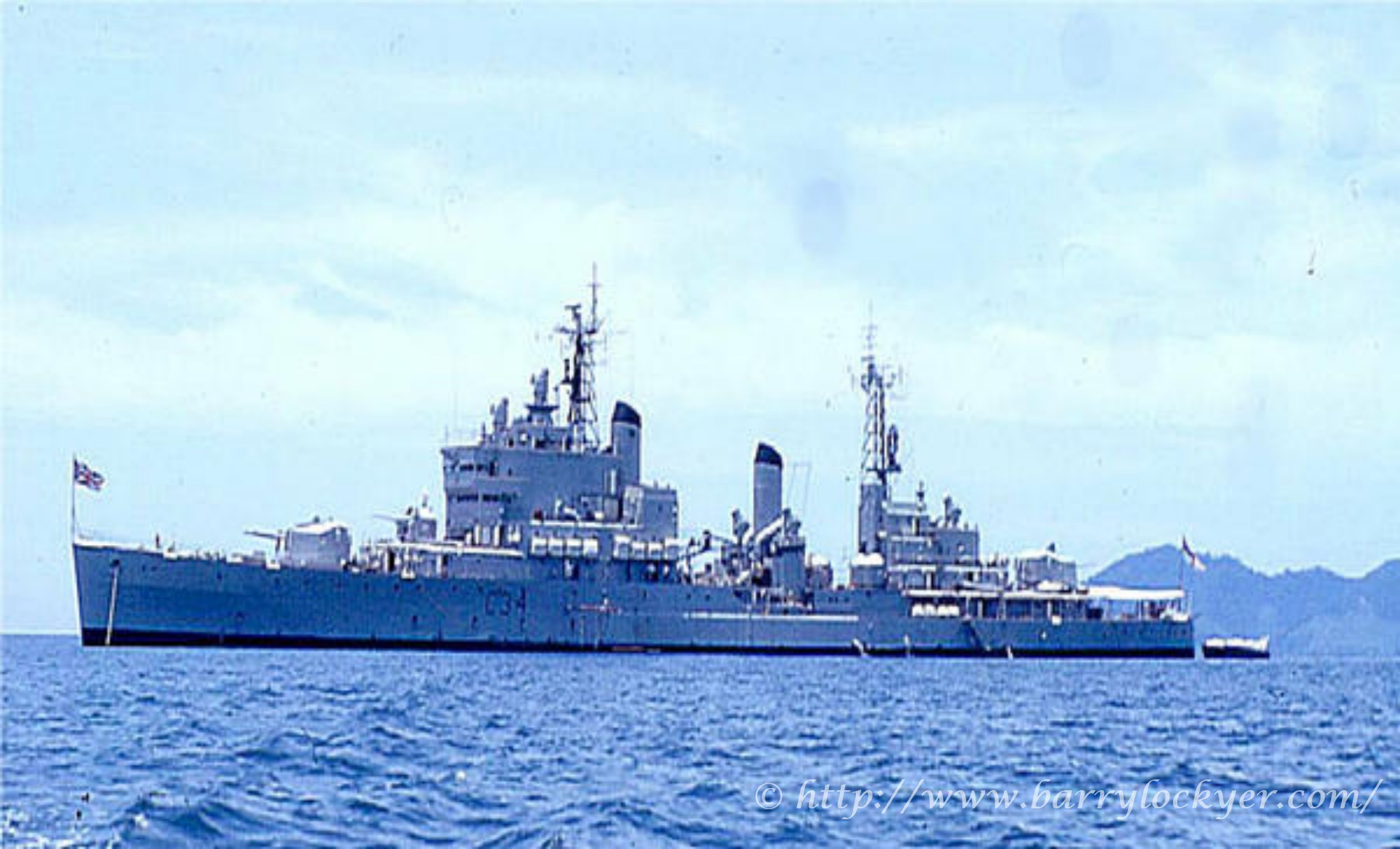
HMS Lion (C34)
(ex Defence)
Built by Scott's, Greenock. Laid Down 24 June 1942. Launched 2 September 1944.
Renamed 1957. Completed 20 July 1960 by Swan Hunter, Wallsend. Paid off 1964. In
reserve 1964-1972, then placed on disposal list. Broken up by Ward,
Inverkeithing, 1975.

HMS Blake (C99)
(ex Tiger, ex Blake)
Built by Fairfield, Govan. Laid Down 17 August 1942. Launched 20 December 1945.
Completed 18 March 1961. Converted to Helicopter Cruiser at Portsmouth,
1965-1969. Paid off December 1979. Placed on disposal list 1981. Broken up by
Shipbreaking (Queenborough) Ltd., Cairnryan, 1982.
From Wikipedia, the free encyclopedia
Twelve ships of the British
Royal Navy have carried the name HMS Tiger, after the
feline tiger.
- The first
Tiger was a 22-gun ship built in
1546,
rebuilt 1570,
in use as a
floating battery after
1600, and
condemned in
1605.
- The second Tiger was a 260-ton discovery vessel recorded in
the Arctic in
1613.
- The third
Tiger was a 32-gun ship launched in
1647,
rebuilt in
1681,
1701, and
1722, and wrecked in
1743.
- The fourth
Tiger was a 50-gun
4th
rate renamed Harwich shortly before launching, and was in
use from 1743
till being wrecked in
1760.
- The fifth
Tiger was a 60-gun
4th
rate launched in
1747. She
sailed out to India where she remained throughout her service, playing
a part in the capture of Calcutta, and in actions at
Cuddalore,
Negapatam and
Pondicherry. She was made a hulk in 1761 and sold in Bombay four
years later.
- The sixth
Tiger was the 74-gun
Spanish
Tigre captured in
1762 and
sold 1784.
- The seventh
Tiger was a 4-gun
hoy purchased in
1794 and
sold 1798.
- The eighth
Tiger was a 12-gun
brig in
service from
1808 to
1812.
- The ninth
Tiger was a wooden-hulled
paddle sloop launched in
1849,
reclassified as a
frigate
in 1852,
and lost in action at
Odessa
in 1854.
- The tenth
Tiger was a 380 ton
destroyer launched in
1900 sunk
in 1908
during an exercise in the
English Channel south of the
Isle of Wight. Tiger crossed the bows of
HMS Berwick and was sliced in two, 28 lives were lost.
- The eleventh
Tiger was a
battlecruiser launched in
1913.
Served in
World War I, and was badly damaged in the
Battle of Dogger Bank (1915) and the
Battle of Jutland, but resumed service after repairs. Scrapped in
1932.
- A Tiger
cruiser
was ordered in
1942,
renamed to Bellerophon and Blake, cancelled in
1946, and
later completed as
Blake (C99).
- The twelfth
Tiger (C20) was a
guided missile cruiser launched in
1945 as a
light cruiser, later converted, and in service until
1978.
-

An excellent photograph of Tiger at Melbourne, December 1st
1977, courtesy of John Kent.

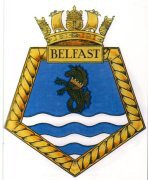
HMS
Belfast/Bellerophon, Reserve Fleet Portsmouth, 1966/67


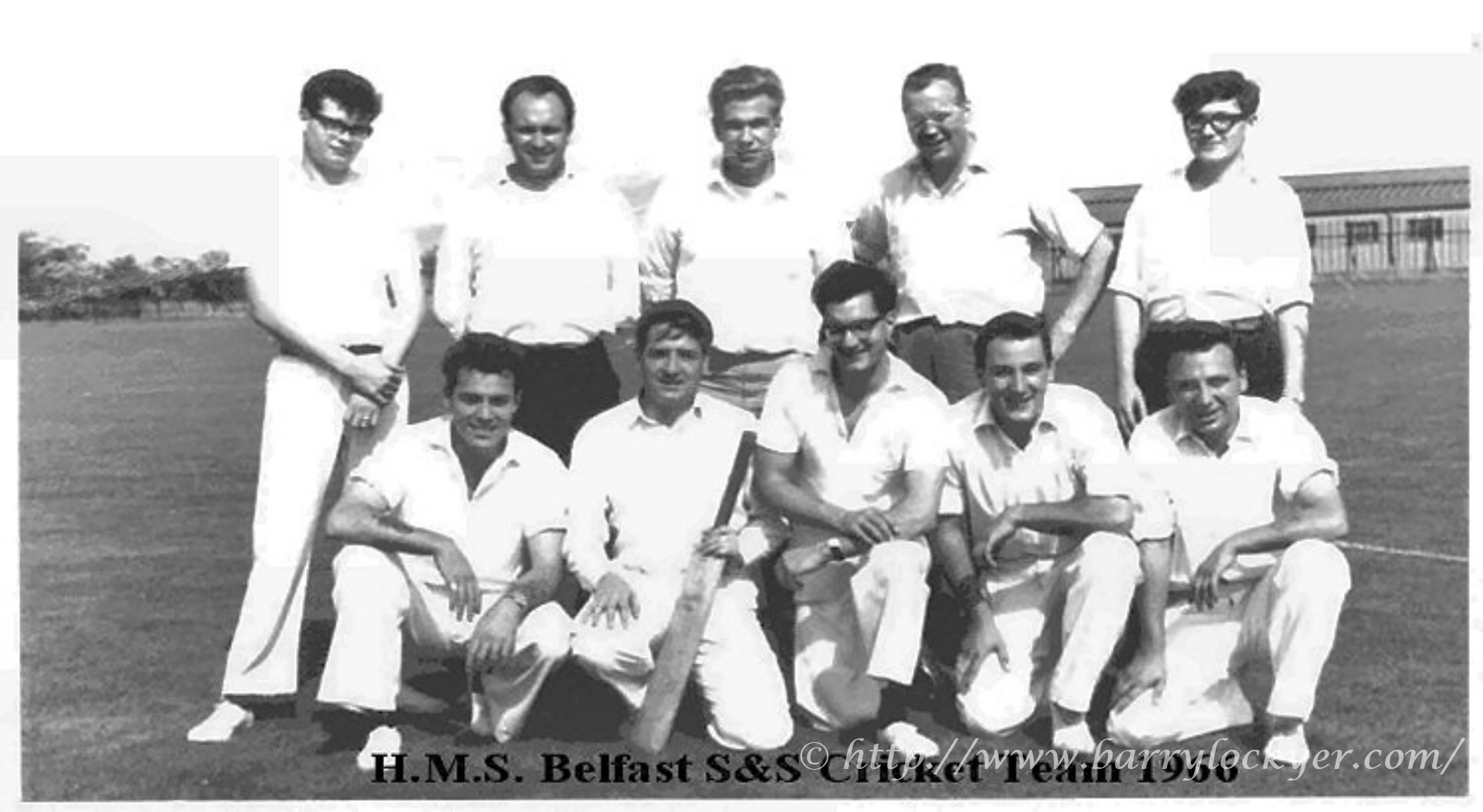
H.M.S.
Belfast (Bellerophon),
Whale Island, S&S Cricket Team 1966,
Sorry
guys, I can't remember any names, I'm 2nd from left front, I assume the eleventh
man took the photograph, any ideas.?
H.M.S. Belfast Association, Honorary Secretary, Mr. Ted Hill (tel:
01708 341 803).
H.M.S. Belfast Imperial War Museum
http://www.iwm.org.uk/belfast/index.htm

Two of my
granddaughters, Madison and Liberty Pickett, August 17th 2004.

Download your ship' commission book from this site, if it is not there, send
David a copy and he will convert it to Adobe .PDF file for downloading.
http://www.axfordsabode.org.uk/comishbk.htm?refresh=0.18759828884163848

HATTERAS 2014
- Since 1943 near the anniversary of the Bedfordshire's sinking,
members of the National Park Service, U.S. Coast Guard, and British Royal Navy
join visitors and local citizens to honor the service of the men buried in the
cemeteries.
Two ceremonies will be held in May to honor the sacrifices of
foreign sailors who gave their lives during World War II protecting the coast of
the United States.
The British War Grave ceremonies will take place on
May 8, at 11 a.m. at the British Cemetery in Buxton and on May 9, at 11 a.m. at
the British Cemetery in Ocracoke. The ceremonies honor the 63 foreign sailors
who lost their lives just off the coast of the Outer Banks.
Several
students will participate in Ocracoke ceremony. Alma Flores will be read the
history and Wyatt Norris will read the list of names. Amanda Gaskins and Adam
Carter will hand out programs for the ceremony. In Buxton, Kate Tawes and Macy
Quidley will do a reading. Krystle and Kendal Woods will hand out programs.
The traditional remembrance will continue as officers place wreaths at the
graves and local citizens read the names of the dead. While the sounding of
"Taps" and a 21-gun salute may conclude the memorial services every year, the
memory of those lost will continue.
During World War II, German
U-boats hunted along the Eastern Seaboard. Unprepared for the attacks, the U.S.
accepted assistance from the British Royal Navy, who helped patrol coastal
waters. In April 1942, British armed tanker San Delfino was sunk by the U-203
just off Pea Island. Two bodies washed up on the shore of Hatteras Island about
a month after the attack and are buried in Buxton.
In May 1942, HMS
Bedfordshire was destroyed by German submarine U-558 near Ocracoke Island. The
bodies of Sub-Lieutenant Cunningham and Ordinary Telegraphist Second Class Craig
were found in the surf off Ocracoke Island on May 14 and buried with appropriate
military honors in Ocracoke. A week later, two more bodies were found in the
ocean north of Ocracoke. These men, although never identified, were assumed to
have come from the Bedfordshire, and were interred alongside their shipmates in
what would become the Ocracoke British Cemetery.
Today, the U.S. Coast
Guard carefully maintains the cemetery at Ocracoke. The graves and cemetery
grounds on Hatteras Island are maintained by the National Park Service and the
Coast Guard Auxiliary.
The ceremonies are organized by the Friends of the
Graveyard of the Atlantic Museum, the Ocracoke community, the U.S. Coast Guard,
Coast Guard Auxiliary 16-04, the National Park Service, the Commonwealth War
Graves Commission, students from the Cape Hatteras Secondary School of Coastal
Studies, students from the Ocracoke School and the Ocracoke Boy Scout troop.
The ceremonies are free and open to the public. For more information, call
the Graveyard of the Atlantic Museum at (252) 986-2995.


Ocracoke 9th May 1997


Ships Company May 1942, one week before sinking and Sub Lt. Tom Cunningham RNVR
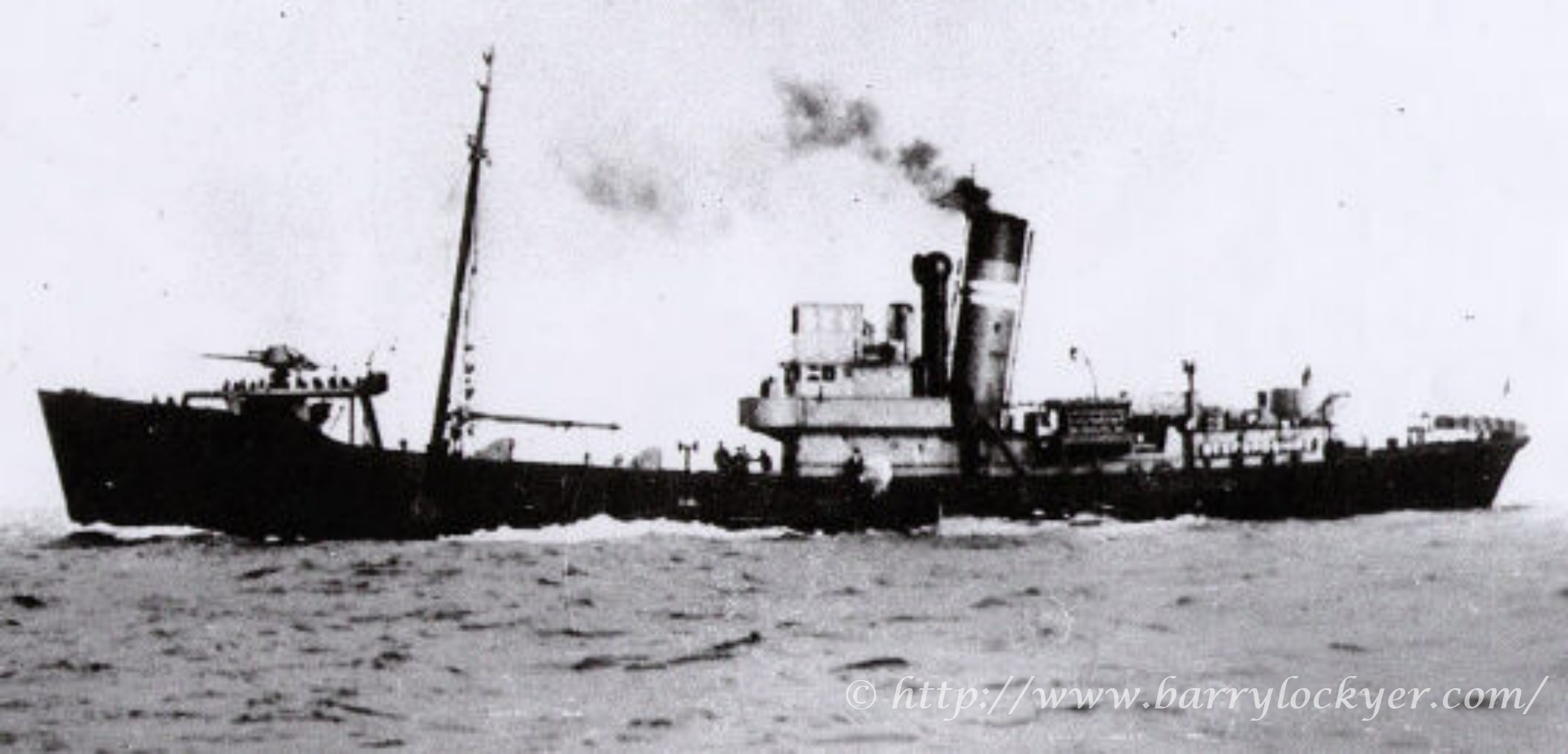
HMS Bedfordshire His Majesty's Armed Trawler.
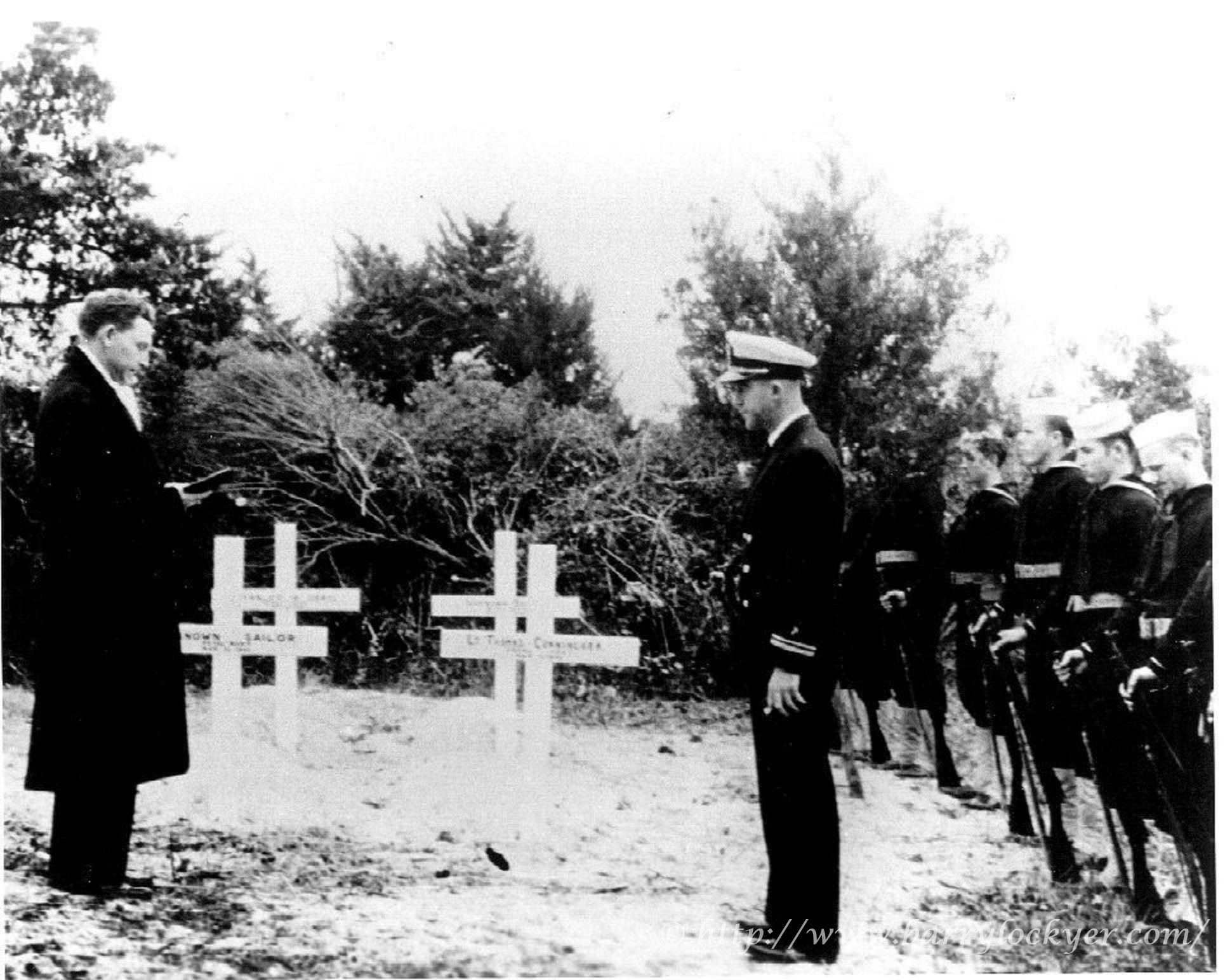
Original Burial Ocracoke, May 1942
-
Casualty List, HMT Bedfordshire. Published in June 1942
Lt. R.B. Davis, RNR (In Command).
Temp. Sub. Lt. H.
Clutterbuck, RNVR.
Temp. Sub. Lt. B. Hall, RNVR.
Temp. Sub. Lt. T.
Cunningham, RNVR.
F.W. Barnes, Engineman.
S. Bennett, Ordinary Seaman.
L.P. Bickford, Seaman.
E.S. Carruthers, Ordinary Seaman.
G.W. Cerrino,
Leading Seaman, RNR.
W.F. Clemence, Ordinary Seaman.
F. Cragg, Ordinary
Seaman.
S .R. Craig, Ordinary Telegraphist.
J.R. Dick, Seaman.
T.M.
Dicks, Ordinary Seaman.
A. Dryden, Seaman.
A.W. Duncan, Chief Engineman,
RNR.
G. Featherstone, Ordinary Telegraphist.
G.H. Fisher, Stoker 2nd.
Class. H. Ford, Seaman.
J. Kelly, Seaman.
W. Lee, Leading Seaman, RNR.
E.W. Lukins, Act. Stoker Petty Officer (Ty).
A.A. McCrindle, Seaman.
A.
McKenzie, Stoker.
F.F. Maltby, Leading Seaman, RNR.
E.N. Morton, Ordinary
Seaman.
W.J. Myers, Stoker.
S.W. Smitten, Ordinary Seaman.
P.E. Stone,
Seaman.
C.T. Travell, Ordinary Signalman.
C.W. White, Ordinary
Telegraphist.
L.J. Williams, Stoker, 2nd. Class.
R. Davis, Ordinary
Seaman, RCN.
J.L. McCauley, Ordinary Seaman RCN.
T. A. Watson, Ordinary
Seaman
The British Cemetery Ocracoke Island North Carolina
This year Sharon and I had the honour of attending the British Cemetery
Ceremonies on Hatteras for the San Delfino 9th May 2013 and on Ocracoke 10th
May 2013, for the HMT Bedfordshire for the annual Remmbrance Services.

Left to Right.
Johnnie Baum Poet, Lt. Jason Rochester, Chaplain, Cdr. Ian Atkins CBE
RN, UK Naval Attache, Cdr. David Trudeau RCN Canadian Naval Attache, Cdr. James
Mitchell Head USCG Sector North Carolina\
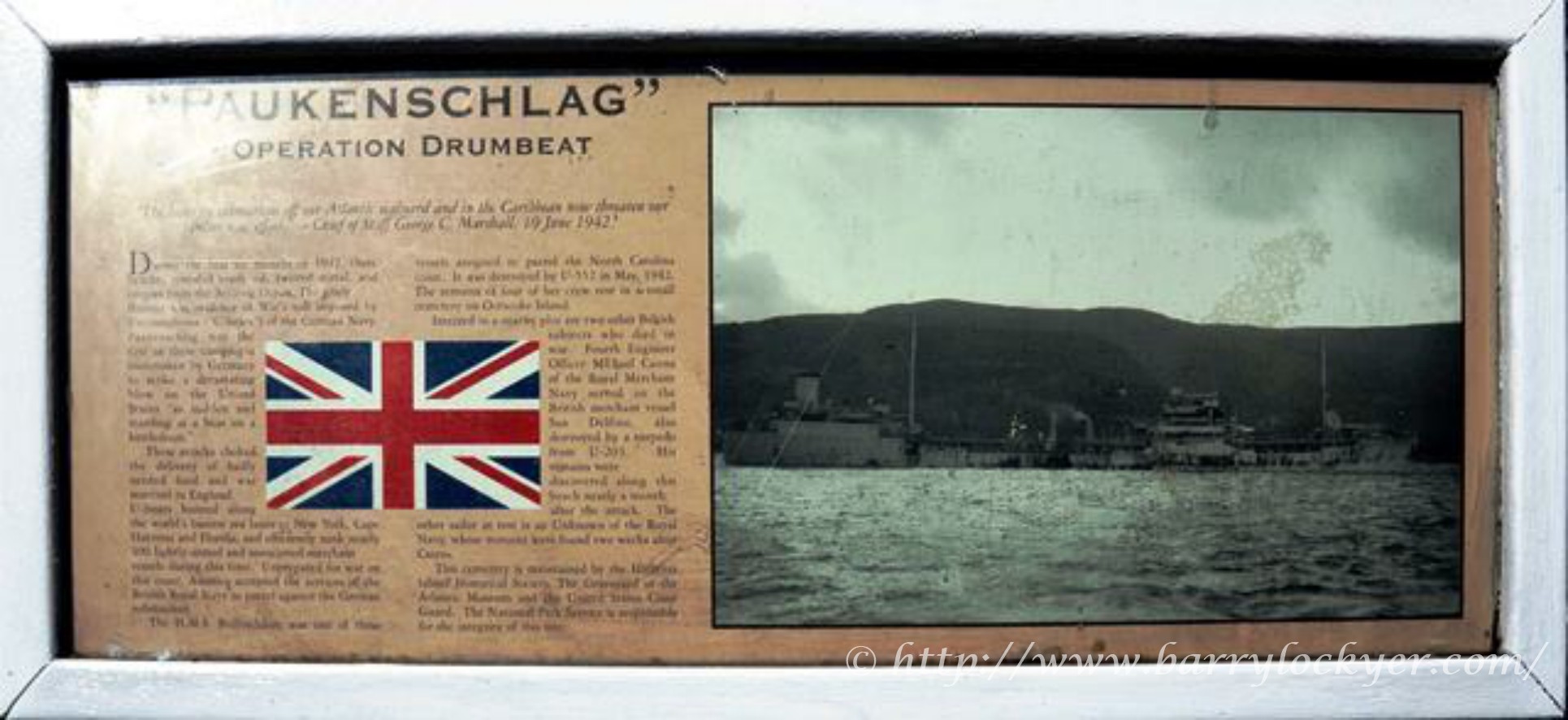
SS San Delfino

R.C. Cochran Sgt. US Coastguard Piping at San Delfino Grave, May 9th 2013



BRITISH CEMETERY 2013
by Johnnie Baum
More than eighty years ago,
they came to this shore.
These brave men who gave their all, in a time of war.
Friends and allies all, they sailed a stormy sea.
Determined on their mission, to keep our nations free.
God’s
hand led them to rest, on this lonely Isle.
And here they will honored, who sailed many a mile.
Guarded here by those, who call the waters home.
Amidst real peace and beauty,
nevermore to roam.
On Ocracoke and Hatteras, they’ve a place to rest.
These men who will remain, among their nation’s best.
Who fought and died for freedom, and with God did stand.
And defeat the evil, which threatened all the land.
Those who did not waver, but charged bravely on.
As many others would, before this war was done.
From Canada and Britain, “twas here they did serve.
And proved to the world, from battle they’d not swerve.
So here they will be honored, on Carolina’s shore.
Who gave for us their all, in a
time of
war.
They have earned the thanks, of all who live free.
And a true safe harbor, off of the storm seas.
This list was compiled by Peter Clark whose father,
Dennis E.A. Clark, served in HMT Norwich City.
Ships lost to enemy action off North Carolina during early 1942.
January
18 -
Allan Jackson,
tanker, sunk by U-66 off Diamond Shoals; 22 killed
19 - Norvana, tanker,
sunk by
U-123 (or U-66?) off Diamond Shoals; 29 killed
19 -
City of Atlanta,
passenger-freighter, sunk by U-123 off Diamond Shoals; 43 killed
19 -
Malay, tanker,
shelled by U-123 off Diamond Shoals; 4 killed
19 -
Ciltvaira, freighter, sunk by U-123 south of Diamond Shoals; 2 killed
19
- Lady Hawkins,
passenger-freighter, sunk by U-66 off Cape Hatteras; 251 killed
22 -
Olympic, tanker,
torpedoed and sunk by U-130; 31 killed
24 -
Empire Gem,
tanker, sunk by U-66 off Diamond Shoals; 49 killed
24 -
Venore, freighter,
sunk by U-66 SE of Cape Hatteras; 17 killed
February
02 -
Amerikaland, ore carrier, torpedoed and sunk by U-106; 29 killed
08 - Ocean
Venture, freighter, torpedoed and sunk by U-108; 32 killed
11 - Blink,
freighter, torpedoed and sunk by U-108; 34 killed
15 - Buarque, passenger-
freighter, torpedoed and sunk by U-432
22 - Olympic, tanker, torpedoed and
sunk by U-130
24 - Norlavore, freighter, torpedoed and sunk by U-432; 28
killed
27 - Halo, tanker, torpedoed by U-130
March
07 -
Arabutan, freighter, torpedoed and sunk by U-155; 1 killed
11 - Caribsea ,
freighter, torpedoed and sunk by U-158; 21 killed
12 - John D. Gill, tanker,
torpedoed and sunk by U-158; 23 killed
12 - John D. Gill, tanker, torpedoed
and sunk by U-158; 23 killed
14 - Olean, tanker, torpedoed by U-158; 6 killed
15 - Ario, tanker, torpedoed and sunk by U-158; 8 killed
15 - Ceiba,
freighter, torpedoed and sunk off Nags Head by U-124; 44 killed
16 -
Australia, tanker, torpedoed and sunk by U-332; 4 killed
16 - Olean, tanker,
torpedoed by U-158
17 - Acme, tanker, torpedoed by U-124; 11 killed
17 -
Ceiba, freighter, torpedoed and sunk by U-124; 44 killed
17 - Kassandra
Louloudis, freighter, torpedoed and sunk by U-124
18 - E.M. Clark, tanker,
torpedoed and sunk by U-124; 1 killed
18 - Papoose, tanker, torpedoed and
sunk by U-124; 2 killed
18 - W.E. Hutton, tanker, torpedoed and sunk by
U-124; 13 killed
18 - USS Dickerson shelled by the Liberator; 4 killed
19
- Liberator, freighter, torpedoed and sunk by U-332; 5 killed
21 - Atlantic
Sun, tanker, torpedoed by U-124
21 - Esso Nashville, tanker, torpedoed and
sunk by U-124
23 - Naeco, tanker, torpedoed and sunk by U-124; 24 killed
25 - Narragansett, tanker, torpedoed and sunk by U-105; 49 killed
26 - Dixie
Arrow, tanker, torpedoed and sunk by U-71; 11 killed
26 - Equipoise,
freighter, torpedoed and sunk by U-160; 41 killed
27 - Carolyn, Q-Ship USS
Atik, torpedoed and sunk by U-123, 47 killed
29 - City of New York,
passenger-freighter, torpedoed and sunk by U-160; 26 killed
April
01 - Rio Blanco, freighter, torpedoed and sunk by U-160; 31 killed
02 -
Liebre, tanker, shelled by U-123; 9 killed
03 - Otho, freighter, torpedoed
and sunk by U-754; 31 killed
04 - Ensis, tanker, damaged by gunfire from
U-572
04 - Byron D. Benson, tanker, torpedoed and sunk by U-552; 10 killed
06 - Bidwell, tanker, torpedoed by U-160; 1 killed
07 - British Splendour ,
tanker, torpedoed and sunk by U-552; 12 killed
07 - Lancing, whaling
factory/tanker, torpedoed and sunk by U-552; 1 killed
07 - Kollskegg, tanker,
torpedoed and sunk by U-754; 4 killed
09 - Atlas, tanker, torpedoed and sunk
by U-552; 2 killed
09 - Malchace, freighter, torpedoed and sunk by U-160; 1
killed
09 - San Delfino, tanker, torpedoed and sunk by U-203; 28 killed
10
- Tamaulipas, tanker, torpedoed and sunk by U-552; 2 killed
11 - Harry F.
Sinclair, tanker, torpedoed by U-203; 10 killed
11 - Ulysses, freighter,
torpedoed and sunk by U-160
12 - Stanvac Melboure, tanker, torpedoed by
U-203; 3 killed
14 - Empire Thrush, freighter, torpedoed and sunk by U-203
14 - U-85, submarine, depth-charged, shelled and sunk by USS Roper; 45 killed
16 - Aloca Guide, shelled and sunk by U-123; 6 killed
16 - Desert Light,
freighter, torpedoed and sunk by U-572; 1 killed
18 - Axtell J. Byles,
tanker, torpedoed by U-136;
19 - Empire Dryden, freighter, torpedoed and sunk
by U-572
19 - Steel Maker, freighter, torpedoed and sunk by U-654; 2 killed
19 - Harpagon, freighter, torpedoed and sunk by U-109; 41 killed
20 -
Chenango, freighter, torpedoed and sunk by U-84; 31 killed
20 - Agra,
freighter, torpedoed and sunk by U-654, 6 killed
21 - Bris, freighter,
torpedoed and sun by U-201; 5 killed
29 - Ashkhabad, tanker, torpedoed and
sunk by U-402
May
05 - Lady Drake, passenger-freighter,
torpedoed and sunk by U-160; 12 killed
09 - U-352, submarine, depth-charged
and sunk by USCG Icarus; 14 killed
12 - HMT Bedfordshire,
armed-trawler, torpedoed and sunk by U-558; 37 killed
June
01 -
West Notus, freighter, shelled and scuttled by U-404; 4 killed
03 - Anna,
freighter, torpedoed and sunk by U-404
07 - Pleasantville, torpedoed and sunk
by U-135
19 - YP-389, patrol craft, shelled and sunk by U-701; 6 killed
24
- Ljubica Matkovic, freighter, torpedoed and sunk by U-404
25 - Nordal,
freighter, torpedoed and sunk by U-404
25 - Manuela, freighter, torpedoed and
sunk by U-404; 2 killed
25 - Tamesis, freighter, torpedoed by U-701
27 -
British Freedom, tanker, torpedoed by U-701
28 - William Rockefeller, tanker,
torpedoed and sunk by U-701
30 - City of Birmingham, passenger ship,
torpedoed and sunk by U-202; 9 Killed
http://www.ocracoke-nc.com/cemetery/
http://www.bbc.co.uk/threecounties/content/articles/2005/02/15/hms_bedfordshire_feature.shtml
Link to The Royal Naval Patrol Service
http://www.rnps.lowestoft.org.uk/index.htm




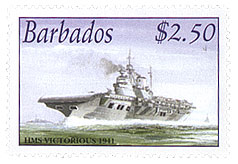
Barbados (Royal Navy) Stamps issued May 2003, worth including in any collection,
order direct from the Barbados Post Office.
http://bps.gov.bb/index.php?ZZZ=1_1055_10_0_0_&YYY=17_46

 Royal Navy
Royal Navy



















































